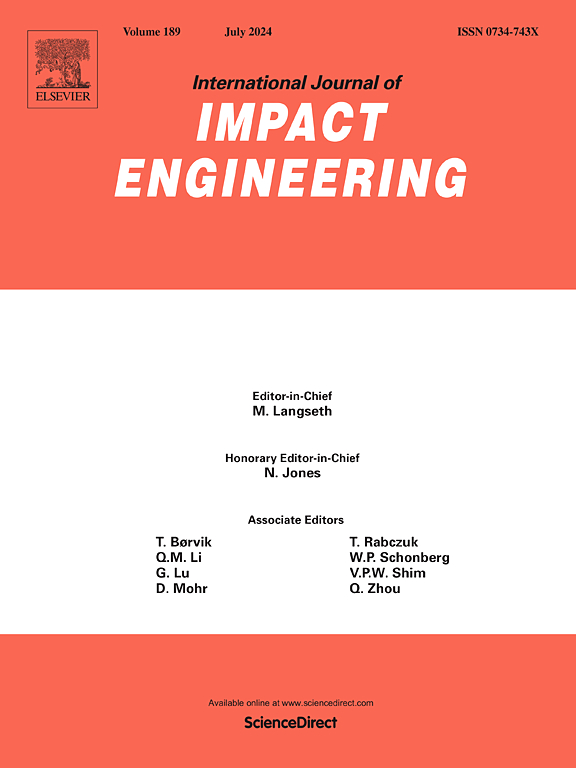高地应力与爆炸应力场耦合作用下的爆炸裂纹扩展机制
IF 5.1
2区 工程技术
Q1 ENGINEERING, MECHANICAL
International Journal of Impact Engineering
Pub Date : 2025-10-04
DOI:10.1016/j.ijimpeng.2025.105549
引用次数: 0
摘要
为明确岩石工程爆破中高地应力与爆炸应力场耦合作用下的裂纹扩展机理,本研究通过理论分析、室内实验和数值模拟,定量探讨了这种耦合作用对岩石裂纹扩展的影响。通过对不同围压爆破模型试验中裂纹扩展过程和破裂形态的分析,同步模拟爆炸诱发裂纹的动态过程,并与试验结果进行对比,结果表明,围压和爆炸应力场的耦合改变了岩石裂纹尖端的弹塑性区和应力分布,改变了裂纹扩展路径和速度。在单向围压下,相同方向的围压使试件的拉应力集中在加载方向,裂纹扩展长度比无围压时增加了76.5%。在垂直方向上,出现压应力集中,裂纹扩展长度减小了39.5%。在双向等围压条件下,压应力显著抑制裂纹扩展,x、y方向裂纹长度比无围压条件下分别减小76.3%和52.9%。裂纹扩展方向更倾向于与围压应力场方向一致。正向入射的爆炸应力波形成I型裂纹,斜向入射形成I + II型复合裂纹。与无围压相比,在围压产生压应力的方向上,裂纹尖端的峰值应力强度因子降低了74.3%,有效应力降低了47.6%。围压同时提高了岩石的抗压强度和应力波的衰减速度,增加了裂纹扩展所需的能量。在围压产生拉应力的方向上,裂纹扩展速度提高26.0%,有效应力提高36%,裂纹扩展所需能量降低。研究揭示了耦合作用下的裂纹扩展机理,为矿山岩石工程爆破的设计和施工提供了理论依据和技术支持。本文章由计算机程序翻译,如有差异,请以英文原文为准。
Mechanism of explosive crack propagation under the coupling of high crustal stress field and explosion stress field
To clarify the crack propagation mechanism under the coupling of high ground stress field and explosion stress field in rock engineering blasting, this study quantitatively explores the influence of this coupling effect on rock crack propagation through theoretical analysis, laboratory experiments and numerical simulation. By analyzing the crack propagation process and fracture morphology in different confining pressure blasting model experiments, and synchronously simulating the dynamic process of explosion-induced cracks and comparing with experiments, the results show that the coupling of confining pressure and explosion stress field changes the elastic-plastic zone and stress distribution at the crack tip of rocks, as well as the crack propagation path and speed. Under unidirectional confining pressure, the same-direction confining pressure causes tensile stress concentration in the loading direction of the specimen, and the crack propagation length increases by up to 76.5 % compared to no confining pressure. In the vertical direction, compressive stress concentration occurs, and the crack propagation length decreases by up to 39.5 %. Under bidirectional equal confining pressure, compressive stress significantly inhibits crack propagation, and the crack lengths in the x and y directions decrease by 76.3 % and 52.9 % respectively compared to no confining pressure. Moreover, the crack propagation direction is more inclined to be consistent with the confining pressure stress field direction. The explosion stress wave incident in the positive direction induces type I cracks, and the oblique incidence forms type I + II composite cracks. Compared with no confining pressure, in the direction where confining pressure generates compressive stress, the peak stress intensity factor at the crack tip decreases by up to 74.3 %, and the effective stress decreases by up to 47.6 %. Confining pressure simultaneously enhances the compressive strength of rocks and the attenuation speed of stress waves, increasing the energy required for crack propagation. In the direction where confining pressure generates tensile stress, the crack propagation speed increases by 26.0 %, the effective stress increases by 36 %, and the energy required for crack propagation decreases. The crack propagation mechanism revealed by this study under the coupling effect provides theoretical basis and technical support for the design and construction of rock engineering blasting in mines.
求助全文
通过发布文献求助,成功后即可免费获取论文全文。
去求助
来源期刊

International Journal of Impact Engineering
工程技术-工程:机械
CiteScore
8.70
自引率
13.70%
发文量
241
审稿时长
52 days
期刊介绍:
The International Journal of Impact Engineering, established in 1983 publishes original research findings related to the response of structures, components and materials subjected to impact, blast and high-rate loading. Areas relevant to the journal encompass the following general topics and those associated with them:
-Behaviour and failure of structures and materials under impact and blast loading
-Systems for protection and absorption of impact and blast loading
-Terminal ballistics
-Dynamic behaviour and failure of materials including plasticity and fracture
-Stress waves
-Structural crashworthiness
-High-rate mechanical and forming processes
-Impact, blast and high-rate loading/measurement techniques and their applications
 求助内容:
求助内容: 应助结果提醒方式:
应助结果提醒方式:


